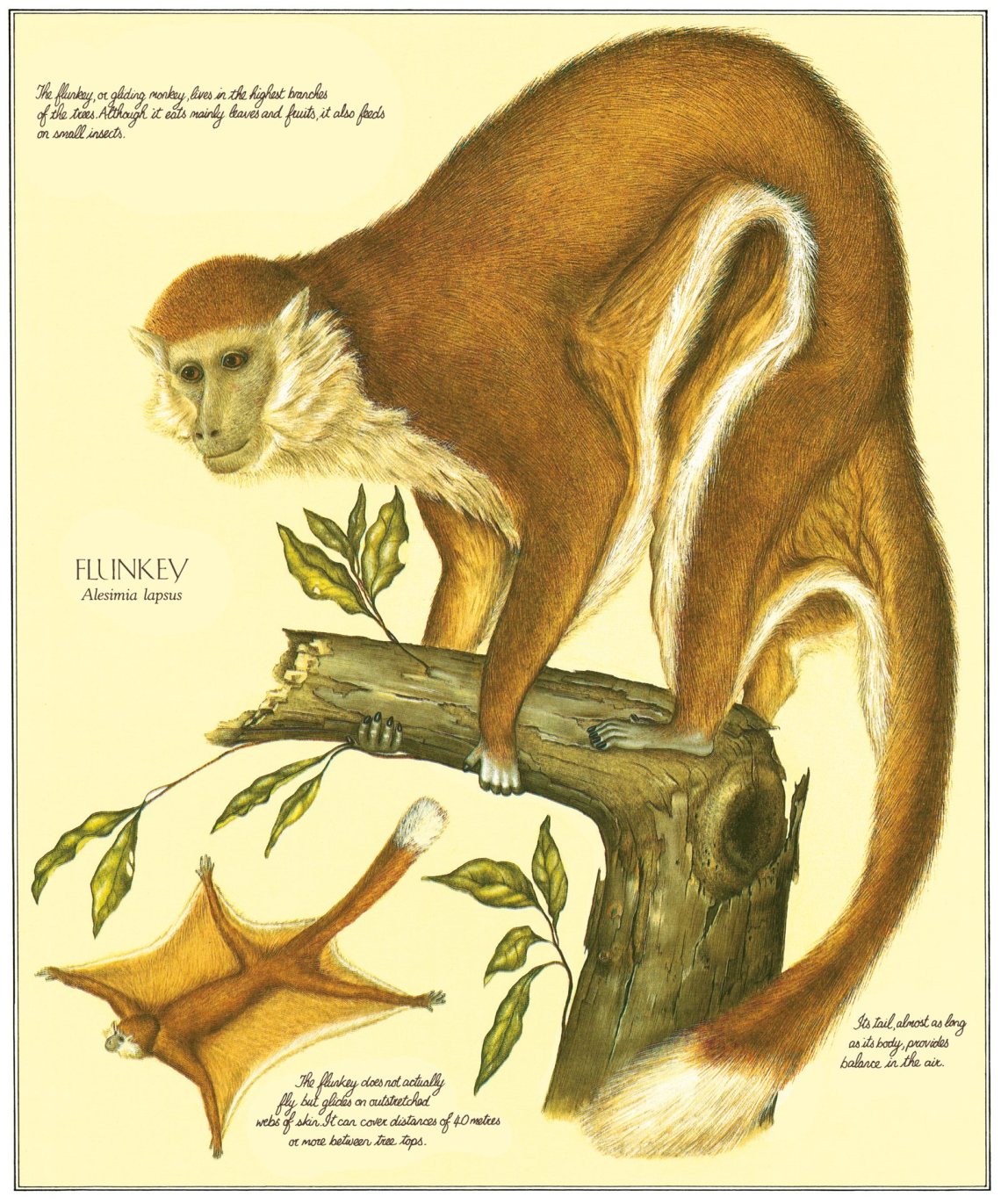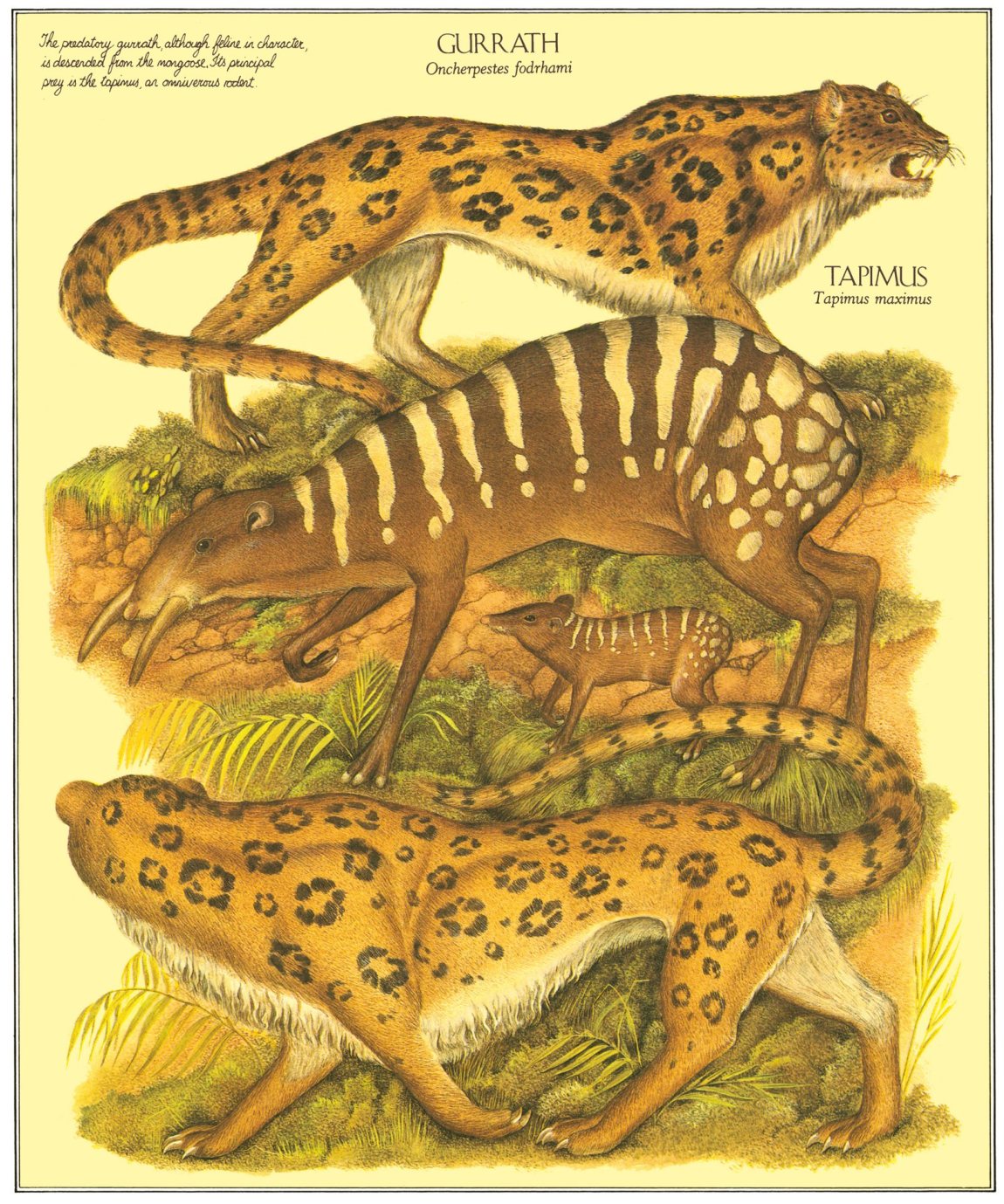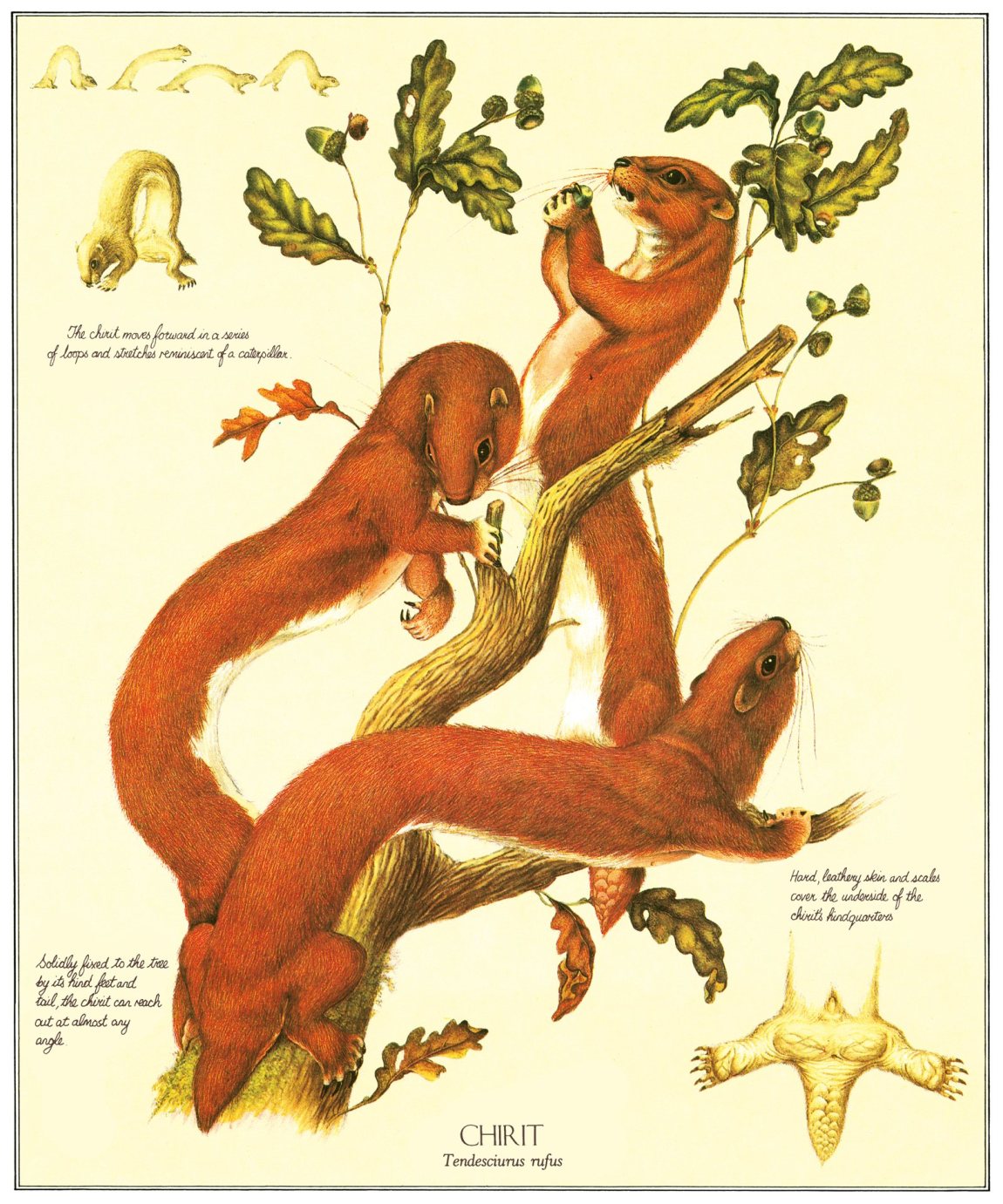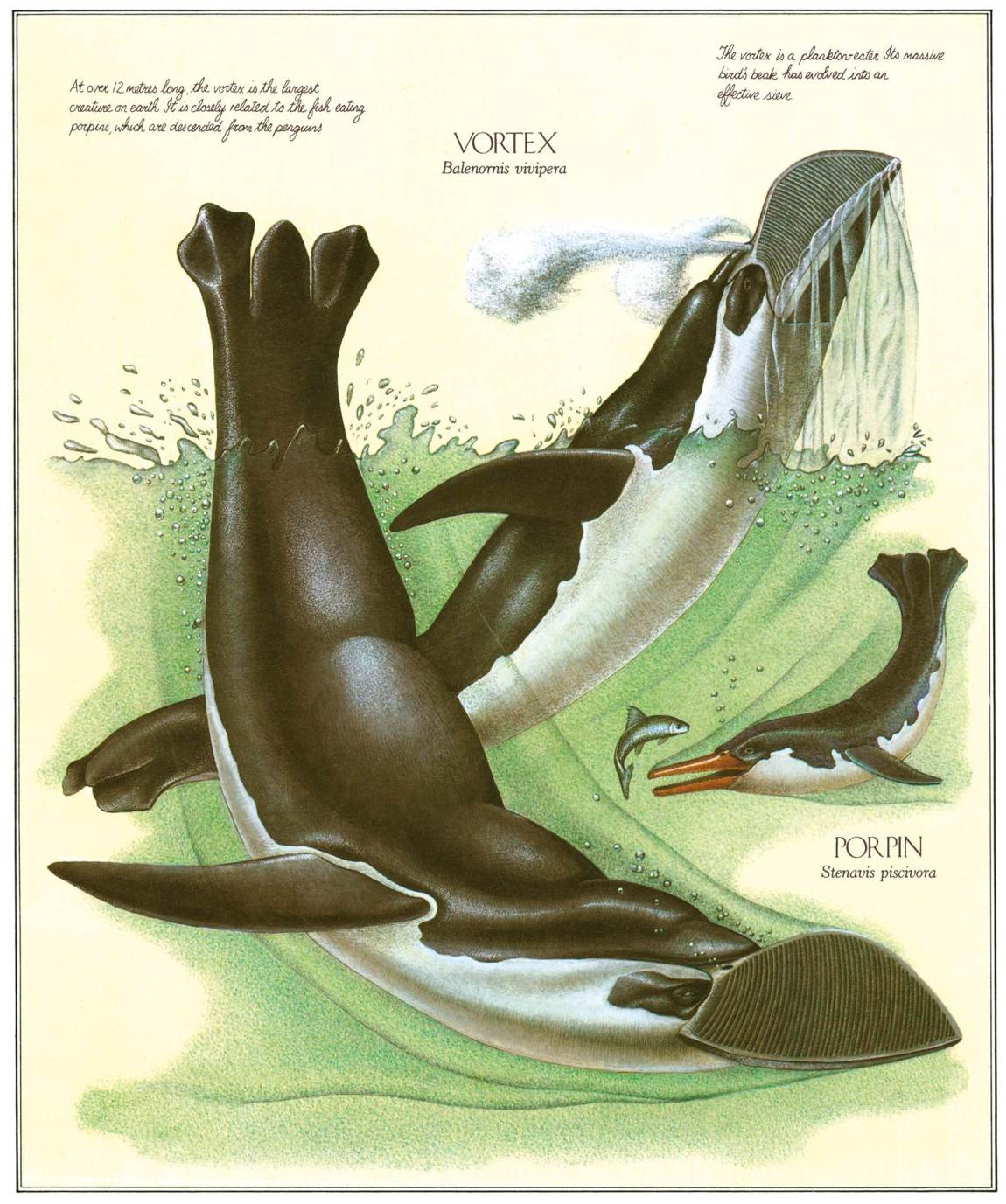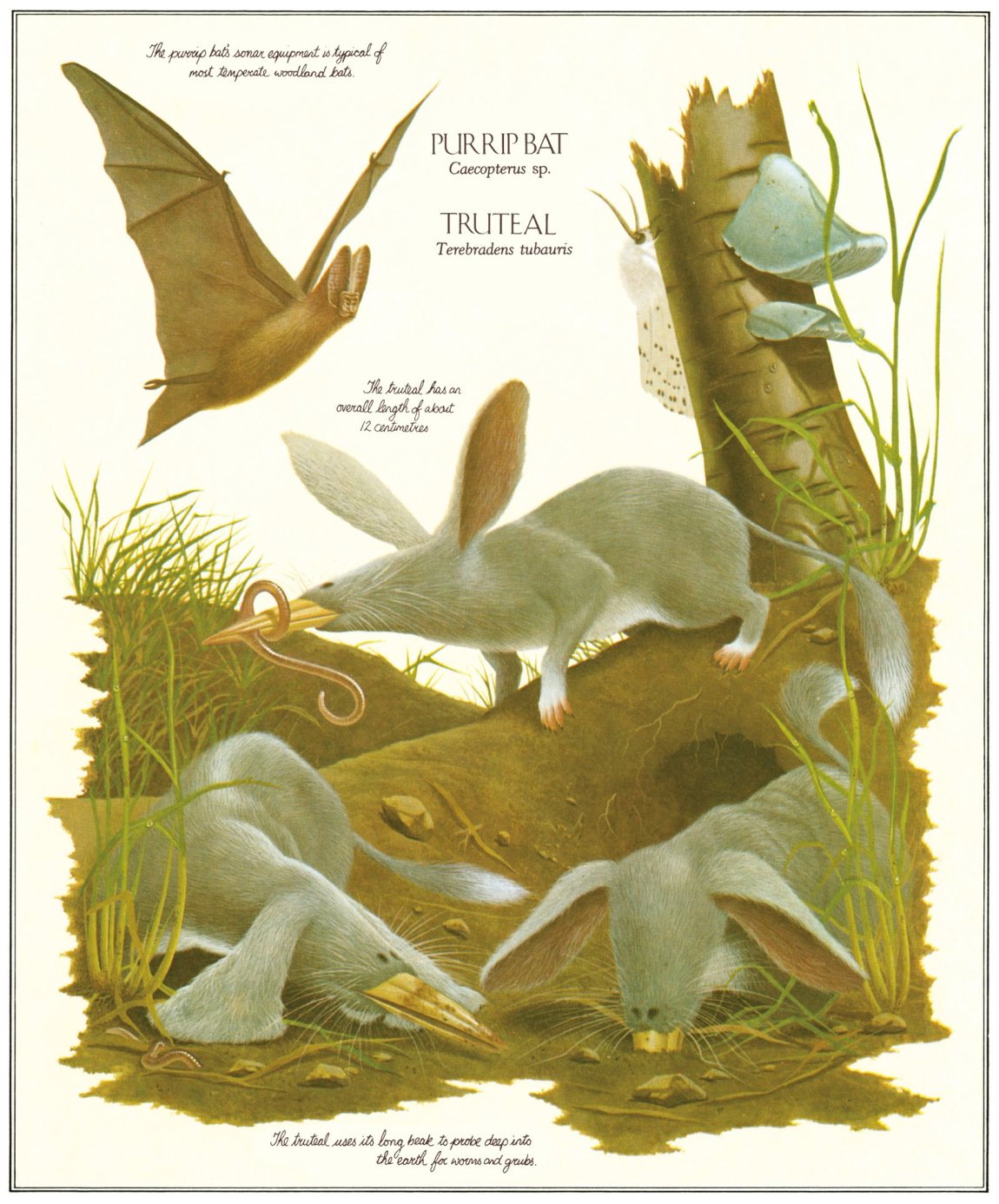In this era of ecological collapse and cascading extinctions one feels a desire, latent in our species, to see the world become wild again. The only way, it seems, is to take the long perspective: knowing that someday, after we are gone, the earth will again host rich biodiversity. Time heals all wounds—even if it will take millions of years.
For insights on the scale of millions of years, we turn to geologists, whose specialty is mapping the cycles of the earth through deep time. This year, Breakdown Press republished After Man, a book by the Scottish geologist Dougal Dixon that imagines how other species will evolve after humans go extinct, fifty million years in the future. It’s a premise that has aged well, as anxiety over our long-term damage to the planet grows; the book has been reissued a dozen times since its publication in 1981. Reading it today, it has itself become a time capsule of an earlier period of environmental and scientific thought. In 1981, geologists had not yet proposed that we are living in a new epoch defined by human activity, the Anthropocene; climate change was popularly understood not in terms of warming, but of a coming ice age; the specter of a sixth mass extinction, the sort Dixon’s book is premised on, did not seem to loom on the horizon as it does today. Yet science writing was “riding a wave of popularity,” according to a New York Times headline of that year; a mainstream market for nonfiction by scientists, not just popular science writers, was flourishing, buoyed by figures like Carl Sagan and Richard Leakey.
Dougal Dixon’s field was zoogeography, and as a geologist he spent a lot of time thinking about how the changing earth has altered the species that live on it. His future earth, continental drift aside, looks basically unchanged after fifty million years. It’s an almost nostalgic vision: the megafauna that were driven extinct during the “Age of Man” have been replaced by new species that bear an uncanny resemblance to their predecessors. Humanity’s enduring legacy is not its alteration of the environment—Dixon purposely keeps the climate similar to today’s—but that the extinctions we have precipitated will have left behind an array of empty niches, to be filled by whatever adaptable species are able to take advantage of them. Imagine a game of biogeographical musical chairs in which penguins have evolved comb-like beaks to sieve plankton as whales do, rats have replaced the big cats as dominant carnivores, cats swing through the tropical canopy chasing monkeys, and monkeys glide on flaps of skin like flying squirrels. The book’s central idea is convergent evolution: that similar traits arise independently in different species, to perform similar functions in similar environments.
The world is presented as a series of ecosystems that cover seven biomes, lushly illustrated after Dixon’s designs by a handful of artists, and painstakingly described down to the details of symbioses, mating rituals, diets, and seasonal adaptations of their inhabitants. Dixon’s taxonomy is far from comprehensive (he neglects the oceans, plant life, and insects) but as a thought-experiment, After Man is an effective primer on evolutionary genetics and natural selection. Still, he sometimes wonders whether people see his work simply “as picture books of funny animals.”
Though some of his imagined fauna are delightfully weird—like the “parashrew,” a vole-like creature whose tail functions as a parachute that carries adolescents on the wind like seeds; or a species of bird in which the male, as though taking a cue from the anglerfish, fixes himself on the tailbone of a female, taps a vein, and provides her with a lifetime’s supply of sperm—the strangest thing about After Man may be the absence of a globally dominant species. Opportunistic, “r-selected” species—those, like rodents, that have high birth rates and low survival rates—that thrived during the Age of Man, evolve into the top predators and herbivores in most ecosystems, becoming large and toothy. Invasive species, introduced by humans into new habitats, maintain their advantage in the food chain, like the mongoose that evolves into a formidable jungle carnivore called a “gurrath.” But “intelligent life,” we are told by the book’s nameless narrator, “appears briefly on the earth. Industry and agriculture have a dramatic effect.” Humans go extinct, Dixon suggests, because we lose our evolutionary advantage by adapting our environment to our needs, rather than the other way around. When the resources needed to maintain our civilizations run out, we are unable to adapt quickly enough to survive. Crucially, nothing takes our place, and the planet reverts to an Edenic state, uncorrupted by knowledge.
Advertisement
*
Among the attributes that psychologists often cite to distinguish humans from other species and explain our unique evolutionary success, our ability to plan by inventing possible future scenarios usually tops the list. So it’s not surprising that speculative evolution, the practice of imagining the myriad forms life could take, has developed into a movement on the Internet since Dixon’s book. Some scientists consider it a guilty pleasure, tangential to their work in paleontology or evolutionary biology. For many amateur speculative biologists, who call themselves “speccies,” speculating in online forums about possible life forms in other epochs and on other planets is an all-consuming hobby.
In such circles, Dixon is venerated like Darwin. What if birds, rather than mammals, had dominated the Cenozoic? Suppose the Bonarelli Event had never occurred? What would chemosynthetic organisms on Titan look like? Earth in twenty million years if hit by a meteor in 2050 that wipes out 80 percent of all species: go! Speculative world-building is a creative act, and appeals to many of the same people who are into sci-fi and fantasy gaming: there are elaborate rules—the rate of energy transfer through trophic levels, the basics of genetic inheritance—but the rest is up to you. The more hardcore speccies have to take forced hiatuses from their projects on the Spec World wiki because they have become disconnected from their real lives. Desmond Morris, who wrote the introduction to After Man, said that the “biomorphs” he invented as a young zoologist “became as real to me as the animals and plants of the natural world.”
For paleontologists, speculative biology isn’t such a radical concept. Hypothesizing about what dinosaurs and other extinct species may have looked like, or how they may have lived, based on the fossil record, requires a significant amount of extrapolation that can’t necessarily be proven by marks in the strata. Among paleo-artists, there are those who are sensitive to the biological constraints of their subjects, drawing their brachiosauruses from the bones up; others, more reckless and stylistic, draw dinosaurs that look like other artistic impressions of dinosaurs. Among scientists themselves, different camps disagree on how much speculation about the past is appropriate. Speaking of the challenges in writing The New Dinosaurs, his 1988 book that speculated about what dinosaurs would look like today if the meteor had never wiped them out, Dixon uses language that may sound peculiar to those who assume scientific disputes eschew partisanship:
I remember at the time thinking that—to make this work, I’m going to have to embrace the extreme left-wing of vertebrate paleontology… even though I was very much a traditionalist (in terms of dinosaurs) when I needed to be.
Dixon expected the most provocative aspect of his project to be its speculative nature. So he was surprised, when After Man was published, that “much of the media claimed it was all about the extinction of man.” He maintained that human extinction was “just a device to get the discussion going,” and not a political statement.
But science fiction as a genre reveals the ways in which scientific pursuit is political, moral, and, above all, existential. During the cold war, nuclear escalation and the space race offered both a vision of the apocalypse and the possibility of escape from it. Science fiction in the Sixties was concerned primarily with the survival of humanity. More terrible even than extinction, perhaps, was the prospect of man’s fall from dominance, an anxiety explored by Pierre Boulle in La Planète des singes (1963) that became the Planet of the Apes franchise (now more popular than ever). Hothouse by Brian Aldiss (1962) imagined a tropical earth dominated by enormous plant life, with the last humans scurrying in the undergrowth, making a final effort to preserve the species. In the Seventies, the burgeoning environmental movement led to a new genre, eco-fiction, whose authors—Ursula K. Le Guin, Louise Erdrich, and Barbara Kingsolver are especially beloved—mourned not the fall of humanity but the degradation of nature and our lost connection to it, and whose utopias didn’t necessarily include humans.
Speculative evolution and science fiction share many of the same fascinations and are mutually inspired, though the former is meant to stay rooted in scientific principles, while the latter veers toward the fantastical. Dixon is one writer among many who have taken inspiration from The Time Machine, the novella by H.G. Wells that popularized the concept of time travel in 1895. After becoming entangled with a woman from the future and narrowly escaping an antagonistic humanoid race called the Morlocks, Wells’s “Time Traveller” keeps driving ahead. He visits the earth thirty million years later, after humans have gone extinct, populated by crab-like animals and oversized lichens. Finally, wanting to be present at the end of the world, he watches as the sun goes out.
Advertisement
The time traveler has become a trope in speculative biology and science fiction, the human witness who brings back a record from uncharted frontiers of time and space. After Man is written as his journal from the future. It’s a useful frame, though it also betrays the discomfort we have with the unknown—the desire to be present at one’s own funeral. We want to be there even when the point is that we’re not there.
*
The first book for a popular audience to articulate the existential stakes of climate change was The End of Nature, published in 1989. Bill McKibben argued that, with the overuse of fossil fuels and its influence on global climate, humans had crossed a threshold in their relationship to the earth: “We have ended the thing that has, at least in modern times, defined nature for us—its separation from human society… Nature’s independence is its meaning; without it there is nothing but us.” Dixon’s harmonious vision of nature, the complexity of its ecosystems restored, every niche filled, does not include people. That makes sense, if humans don’t consider themselves a part of the natural world.
It’s a philosophical distinction—studying human behavior as one would study primates was itself a very radical project when Desmond Morris wrote The Naked Ape in the 1960s, because we have such a hard time conceiving of ourselves as animals at all. As a Surrealist artist and an anthropologist, it was fitting that Morris wrote the introduction to After Man. But he suggests that the distinction is aesthetic as well: Morris cautions that the reader may “feel saddened by the thought that the animals meticulously depicted [here] do not exist now. It would be so fascinating to be able to set off on an expedition and watch them all through a pair of binoculars.” Nature must be sufficiently alien from us to inspire wonder and excite our curiosity—in fact, the species alive today have become so familiar that we apparently require new variations, unexpected and strange, to keep our interest.
But before too long, people will feel disheartened that some of the animals introduced by David Attenborough in “Life on Earth,” which first aired in 1979, can only be seen on film. In fact, after its reboot in 2016, the show faced criticism that it did not convey the threatened or endangered status of most the wildlife it celebrated, instead offering its audience an illusion: a pristine natural world that “exists as if man had never been.” In The Guardian, BBC producer Martin Hughes Hames wrote: “I believe that in 100 years people will be amazed, and profoundly sad, that it was still possible to make such programmes.”
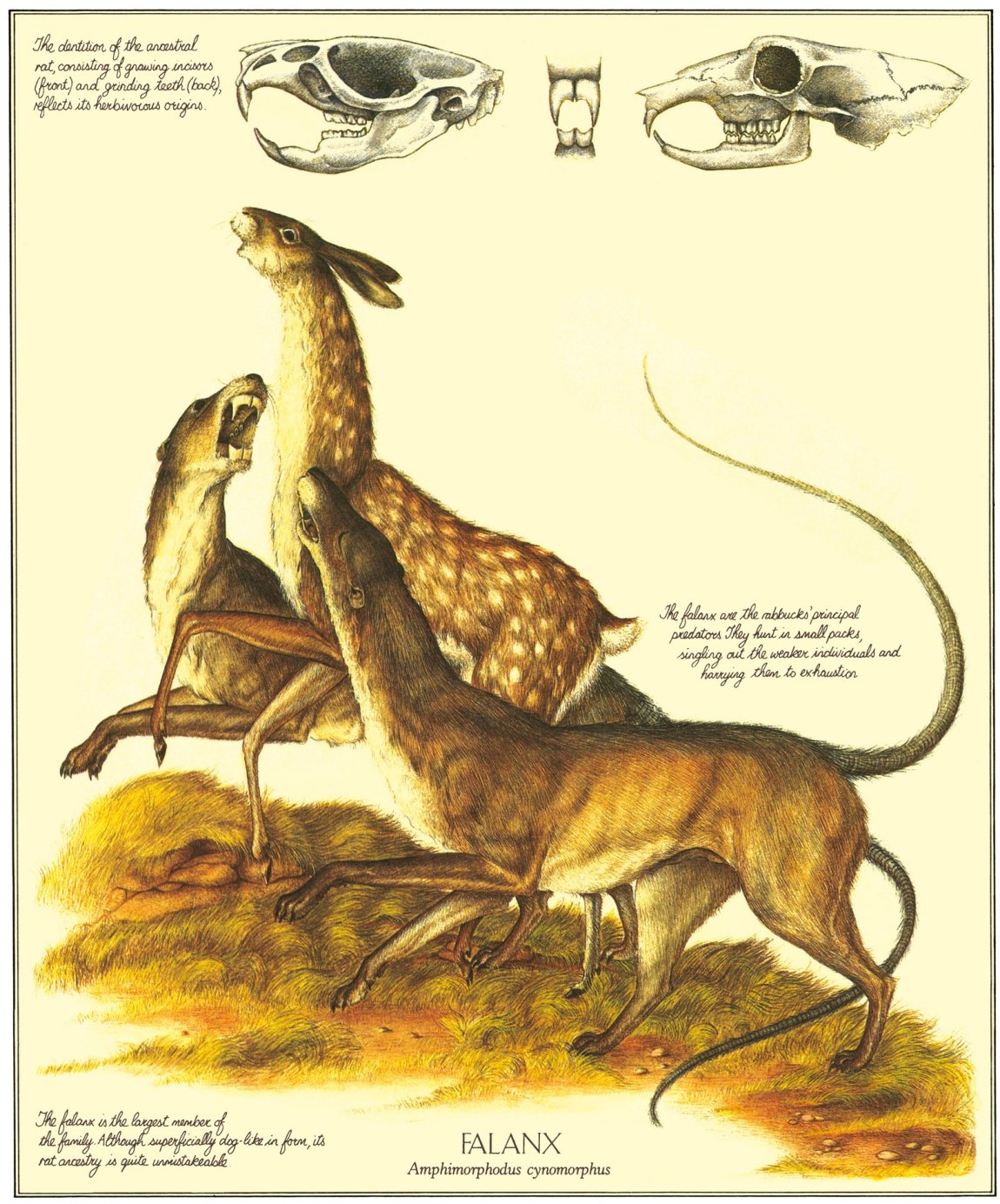
Diz Wallace/Breakdown Press
“The falanx are the rabbucks’ principal predators. They hunt in small packs, singling out the weaker individuals and harrying them to exhaustion…. The dentition of the ancestral rat, consisting of gnawing incisors (front) and grinding teeth (back), reflects it herbivorous origins.”
Fifty million years hence is sufficiently far away that Dixon could sidestep the more urgent questions about humanity’s legacy. But other speculative projects have more recently imagined the world after human extinction. Alan Weisman’s The World Without Us (2007) looks into the nearer future, to the time it would take our infrastructure to collapse and the forest to grow over. Within only centuries, little of our built environment would be recognizable. Not very long—though Weisman cites a climatologist who estimated it will take 100,000 years for the geologic cycle to restore atmospheric carbon dioxide to prehuman levels, and that would only happen if we’d stopped burning fossil fuels ten years ago. Weisman considers the species that live in the last wild preserves and parks not as natural treasures for humans to enjoy now, but as gene banks: seeds that will repopulate the world after humans are gone, and evolve into the sorts of hybrid beasts Dixon describes.
But what if, by hook or by crook, we survive? “Nothing but us” was the dystopian vision of Dixon’s third speculative project, Man After Man, in 1990. Dixon admits that, after the success of After Man and The New Dinosaurs, he felt pressured by his publisher to write Man After Man, a “disaster of a project”:
I thought: right, let’s have the current world collapsing through overpopulation, famine and so on, and the idea that mankind needs to escape destruction. What does mankind do? Invents time travel and moves 50 million years into the future and sets up civilization then. Then what we’ll have is that all the man-made catastrophes, all the ecological disasters… they happen all over again. So I’ve got this world already created in After Man, and I’m now going to destroy it… this was going to be Man After Man.
Instead, the book shows the future evolution of humans, a freak show of genetic engineering, elective surgery, parasitism, and enslavement. Homo sapiens speciates into a menagerie of unrecognizable beings that subdue and exploit each other. It doesn’t really feel like science anymore; it’s more like sci-fi.
For speccies, the end of the world is already a foregone conclusion—and sometimes it feels easier to live there, in that new dawn after the plastics have broken down, when the Anthropocene is just a vein in the rock, and all that humans have wrought is anyone’s best guess. But if the wild tableaux of After Man are escapist fantasies, Man After Man may be the premonition of disastrous success that our species needs now. Survival, Dixon seems to be saying, is overrated.


